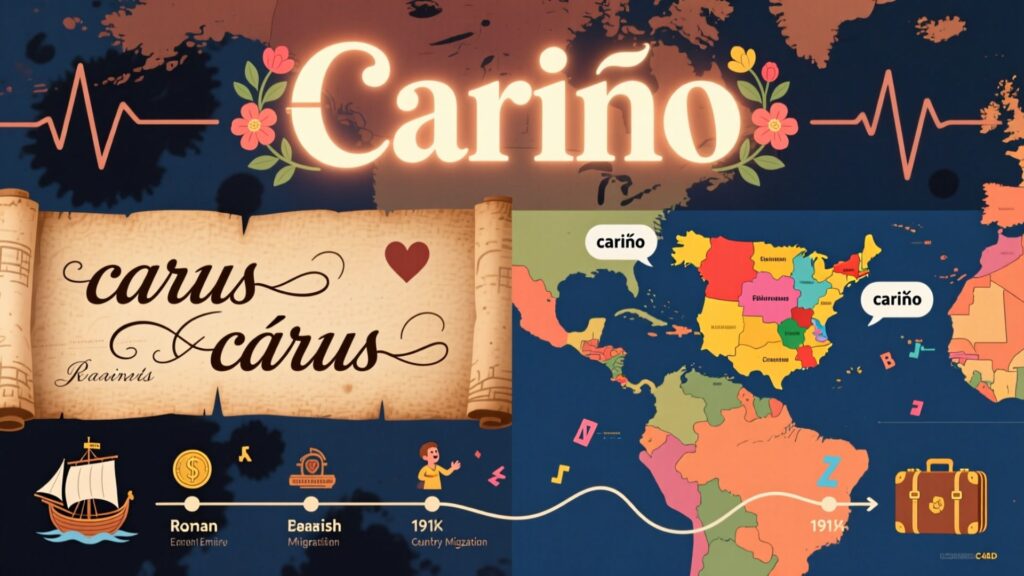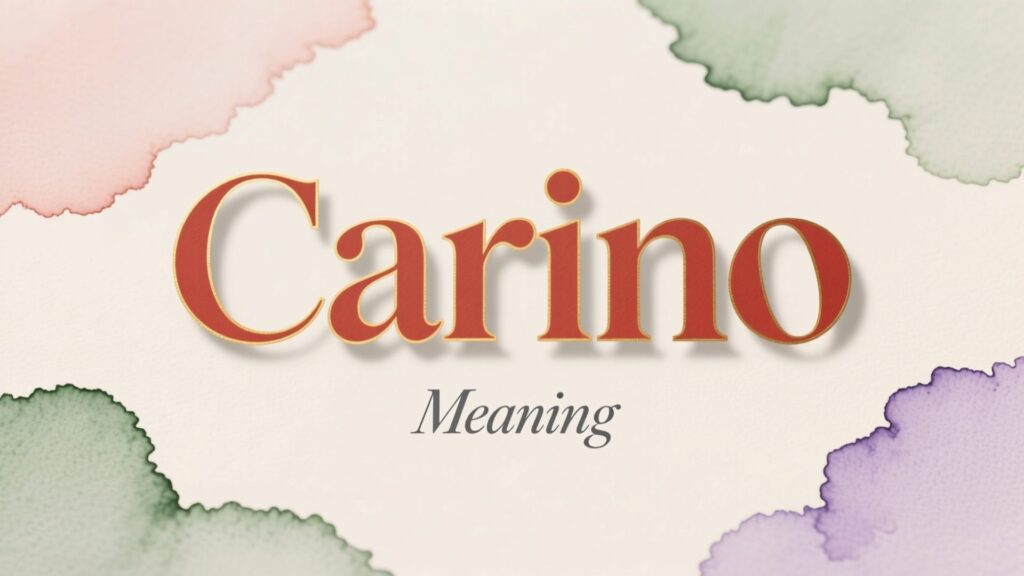Carino Meaning
Language is more than vocabulary it carries culture, emotion, and context. One Spanish word that often catches the attention of non-native speakers is “cariño.” You’ll see it in text messages, hear it in conversations, and even spot it in romantic songs. But what exactly does cariño mean? How should you use it, and are there polite alternatives when you need to sound professional?
This guide breaks it all down. By the end, you’ll know the full carino def, its origins, its cultural nuances, and how to use it correctly in both speech and writing.
What Does Cariño Mean?

At its core, “cariño” is a Spanish noun that translates to “affection,” “love,” or “fondness.” It can also function as a term of endearment similar to “darling,” “sweetheart,” or “dear.”
- Literal translation: affection, tenderness
- Everyday usage: darling, honey, sweetheart, my love
The meaning shifts depending on context. For example:
- A mother might say “Ven aquí, cariño” (“Come here, darling”) to her child.
- A partner might text “Buenos días, cariño” (“Good morning, love”).
- Friends might use it in Spain in a casual, friendly way, closer to “dear” or “mate.”
So when you ask what does cariño mean in English, the answer depends on who is speaking and to whom.
Quick Tip: If you’re wondering is cariño romantic? The answer is: sometimes, but not always. In romantic contexts, yes, but in family or friendship, it simply shows warmth and closeness.
Origin and Linguistic Roots of Cariño

The word “cariño” comes from the Latin word carus, meaning “dear” or “beloved.” This root also gave rise to related words like “charity” in English and caro (expensive/dear) in Spanish.
Over centuries, cariño evolved into a noun describing both the feeling of affection and the person receiving it.
Historical Notes
- First documented in medieval Spanish literature as an expression of emotional closeness.
- Gained popularity in Renaissance-era Spain, appearing in poems and letters.
- Today, widely used across Spanish-speaking countries with slightly different connotations.
How Cariño Is Used in Everyday Language
In practice, cariño is incredibly versatile. Its usage depends on setting, tone, and culture.
Spoken Spanish
- Commonly used in intimate or informal settings.
- Tone of voice can make it sound romantic, playful, or parental.
Example:
- Partner: “Te amo, cariño.” → “I love you, darling.”
- Parent: “Tranquilo, cariño.” → “Calm down, dear.”
Written/Text Usage
In texts or chats, cariño often serves as a sweet sign-off:
- “Buenas noches, cariño ❤️” → “Good night, sweetheart ❤️”
- “Gracias por todo, cariño.” → “Thanks for everything, dear.”
Regional Variations
- Spain: Used freely among friends and family; not always romantic.
- Latin America: Often reserved for closer relationships; more affectionate or intimate.
Common Translations in English
There’s no single perfect English equivalent for cariño. Its translation depends on context.
| Spanish Usage | Possible English Equivalent | Context |
|---|---|---|
| Buenos días, cariño | Good morning, sweetheart | Romantic partner |
| Ven acá, cariño | Come here, darling | Parent to child |
| Tranquilo, cariño | Calm down, dear | Comforting tone |
| Hola, cariño | Hi, love / dear | Casual or romantic |
This flexibility makes the question “what is carino” interesting. It doesn’t always mean “darling.” Sometimes it’s just “affection” itself, without addressing someone directly.
What Does “Hiatus” Mean in the Context of Cariño?
Some learners stumble across the phrase “hiatus in cariño.” Let’s clarify.
- Linguistic hiatus: In Spanish phonetics, a hiatus occurs when two vowel sounds appear together but are pronounced separately (e.g., cariño is not one of these).
- Cultural/Relational hiatus: Sometimes “hiatus” is used metaphorically when the use of cariño creates a pause or awkward gap in professional or cross-cultural communication.
For example:
- In a business email, saying “Hola, cariño” could feel inappropriate, creating a “hiatus” in tone.
So while not a direct dictionary definition, “hiatus” in this context usually refers to a pause or mismatch in communication style.
Tone and Context: When to Use or Avoid Cariño
Not every situation welcomes affectionate terms.
When It Works
- With a romantic partner
- With children or family members
- Between close friends (especially in Spain)
When to Avoid
- In workplace communication (unless you know the culture well)
- With strangers or new acquaintances
- In formal writing or academic contexts
Think of it this way: using cariño is like calling someone “sweetheart” in English. Sometimes it feels right, but in a boardroom meeting, probably not.
Polite, Professional, and Casual Alternatives
If you’re unsure about cariño, here are safer options.
Polite and Professional Alternatives
- Estimado/estimada → “Esteemed” or “dear” (common in letters/emails)
- Querido/querida → “Dear” (formal or polite use)
- Saludos cordiales → “Kind regards”
- Atentamente → “Sincerely”
Casual and Friendly Alternatives
- Amigo/amiga → “Friend”
- Corazón → “Sweetheart/heart”
- Cielo → “Heaven/angel”
- Guapo/guapa → “Handsome/beautiful” (informal compliment)
- English equivalents: buddy, pal, love, dear (depends on region)
Choosing the Right Alternative
The choice comes down to tone, relationship, and context.
Decision-making checklist:
- Who are you speaking to? (friend, boss, partner, stranger)
- What’s the context? (text, email, conversation, formal letter)
- What tone do you want? (romantic, respectful, casual)
- Would this word feel natural in English if reversed?
Example:
- To a colleague: use estimado instead of cariño.
- To your partner: cariño works beautifully.
- To a friend: amigo or corazón fits better.
Real-World Examples and Sentences

Here are practical examples showing how tone changes with different choices.
With Cariño
- “Te extraño, cariño.” → “I miss you, darling.”
- “Gracias por tu ayuda, cariño.” → “Thank you for your help, dear.”
With Alternatives
- “Te extraño, amigo.” → “I miss you, friend.”
- “Gracias por tu ayuda, estimado.” → “Thank you for your help, esteemed one.”
- “Te extraño, corazón.” → “I miss you, sweetheart.”
Notice how each word shifts the level of intimacy.
Nuances and Cultural Sensitivities
Every culture sets boundaries on affectionate language.
- In Spain, calling a stranger cariño at a café is not unusual it’s friendly.
- In Mexico, the same might sound too intimate or flirtatious.
- In Argentina, affectionate terms are widely used but context still matters.
Case Study:
Ana, a Spanish woman, visits Mexico. She says “Gracias, cariño” to a waiter. In Spain, this is polite and warm. In Mexico, the waiter might misinterpret it as romantic.
This highlights why context and cultural awareness are crucial.
FAQs About Cariño
What does cariño mean in English?
It means affection, darling, dear, sweetheart, or love, depending on context.
Is cariño romantic?
Not always. It can be romantic between partners but also parental, friendly, or casual.
Can I use cariño in professional messages?
Generally, no. It’s too intimate for formal or business settings. Use estimado or querido instead.
What is carino used for?
It’s used to express affection, warmth, or closeness in relationships.
Is cariño only Spanish?
It’s Spanish in origin but sometimes adopted into other languages through music and culture.
What does hiatus mean related to cariño?
It usually refers to a mismatch in tone using cariño in an inappropriate context creates an awkward pause.
Summary and Final Thoughts
So, what does cariño mean? At its simplest, it’s affection. But in real life, it’s so much more it’s culture, tone, and relationship rolled into one word.
Here’s what you should remember:
- Cariño mean: affection, darling, dear.
- Is cariño romantic? Sometimes, but not always.
- Use it with care in texts, conversations, or messages.
- Choose polite alternatives like estimado or querido in formal settings.
- Always consider context and culture to avoid misunderstandings.
In short, cariño is a beautiful word when used with the right person at the right time. Mastering its nuance will not only improve your Spanish but also deepen your cultural understanding.
Bugti is the founder of Quoethint.com, a hub for English language tips, writing advice, and grammar guidance. With years of experience in English studies and a passion for clear communication, Bugti created this platform to make grammar and writing easy to understand for everyone.
